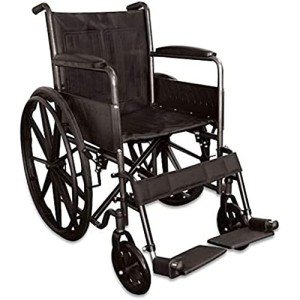Bariatric Wheelchair Seat Width
Seat Width
Having the appropriate seat width is crucial to wheelchair users who invest longer periods in their chairs. Too narrow a seat will trigger pressure on the hips and thighs which could result in sores or pressure points. Having too wide a seat can likewise make it challenging for the user to reach the hand rims to move themselves or maneuver in little spaces.
To measure the appropriate seat width an individual would rest on a chair typically and have their measurement taken throughout their lap at the widest point which is usually their hips. A wheelchair measuring tape can be used to determine this, but a yard stick is preferred as it prevents people from wrapping the tape around their hips which would provide an unreliable result.
The basic wheelchair seat width is 16" (narrow adult), 18" (standard adult), and 20" (wide adult). For self propelled bariatric wheelchair , a 24" seat is readily available. This heavy-duty additional large bariatric wheelchair from Medline includes swing-away footrests, a carbon steel frame with rust- and chip-resistant chrome plating, and easy-to-clean vinyl upholstery. It has a weight capacity of 500 pounds.
Seat Depth
Generally, the seat depth of a bariatric wheelchair was added 2" to the measurement taken at the user's widest point (typically their hips). This was indicated to accommodate additional layers of clothing that might be used during winter. Nevertheless, this practice is becoming less typical as wheelchair users are able to spend more time inside and are not using long coats. This makes the seat depth of a chair lesser when picking a bariatric wheelchair. However, it is still essential to choose an option that provides appropriate assistance for larger users.
The Medline folding additional large bariatric manual wheelchair includes a comfortable 24" seat width and a durable slide tube silver vein frame. It likewise has an adjustable axle and tool-free elevating legrests.
Seat Height
When it pertains to identifying the appropriate wheelchair seat width you need to constantly measure from the user's best point which is typically their hips. You will also require to think about whether the user is going to be using a winter season coat as this may include 2" to the width needed.
When bariatric mobility aids remains in use it ought to only be operated on level surfaces with the wheel locks completely engaged. This is to avoid the chair from being able to move inclines that are 10 degrees or greater. It is also crucial to keep in mind that any activity that might shift the center of mass in the chair must be made with care. This includes grabbing products that need the individual to lean out of their seat or trying to stand from it.
Whenever you have the chair in usage it is advised that you regularly inspect it for damage and lubricate any locations that are deemed required. For instance, the casters must be lubricated by getting rid of the caster fork and utilizing a multi-purpose grease to apply to the caster stem bearings. Likewise, the foot plates can be changed by loosening up the bolt and then moving them to the wanted position. This allows the feet to sit easily on the footplate and prevents any pressure points from forming. This can be really unpleasant for the user and if left unattended, can lead to press sores.
Weight Capacity

Bariatric wheelchairs are created to support more weight than basic wheelchairs. This makes them tougher and much better equipped to manage falls. They are also typically larger and wider, making them less maneuverable in tight areas than standard wheelchairs. They require lorries with special ramps and lifts to pack them, in addition to chauffeurs who know how to best transport them from one location to the next.
When choosing a wheelchair, consider its weight capacity as it will be the main determining consider whether it will accommodate your traveler's requirements. The weight capacity of the chair is typically noted as a static load, meaning that it indicates the quantity of weight the chair can conveniently hold while standing still. However, some producers also list an active load that is based on a drop test and can mimic the impact of someone taking a seat in the chair. This might be a more reputable measurement of the weight limit, depending on your requirements.
If you prepare to carry out activities that move your center of gravity in the seat (such as reaching for things), be sure to have front casters pointed in a forward instructions and wheel locks engaged so the chair will not tip over. Also, inspect that casters are lubed regularly to avoid extreme wear and abrasions. The lubrication treatment involves removing the fork, separating the caster from the wheel, and greasing the caster stem bearings with premium multi-purpose grease.
